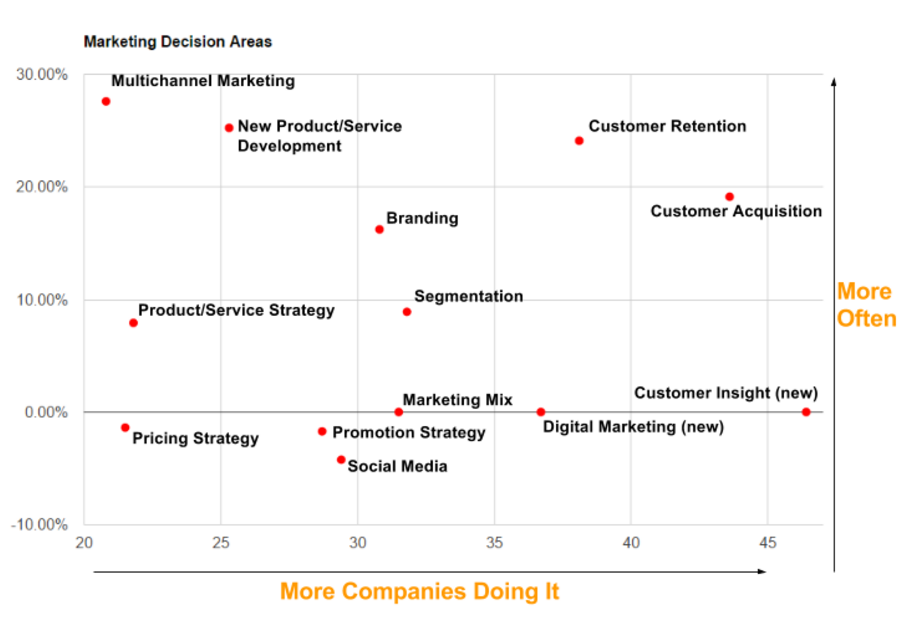A client once referred to the analytics implementation we built for him as a sailboat, and the analogy really stuck with me. Particularly because he wasn’t happy.
“You built me this great sailboat, but I don’t know how to sail it.”
I now view most technical analytics implementation, the tracking and collecting of the actual data, to be analogous to building a boat, where using that data is sailing it. Continuing with the analogy, it’s important when building and sailing a boat, to know what you intend to do with it. It affects the type of boat you want, how it should be built, and what chart to course with it once it’s complete.
If someone wants a boat to comfortably carry 2 people down a lazy river while fishing, they need a different boat, and crew, than someone who wants to sail to Hawaii with his family. With marketing analytics the same ideas apply. What you ultimately want to do with the data, affects what should be implemented, and how it should be analyzed for insights.
It’s not smooth sailing for digital marketers though...
According to a recent study, 84% of marketers said that their ability to make data informed decisions was the most important driver of their success. Yet only 46% said they actually made their marketing decisions based on data, and only 10% believed that they were effective at using the insights. This highlights the first key problems: 45% of the marketers who wanted to make data informed decisions weren’t able to, and of the ones who did almost 80% of them didn’t feel they were being effective.
We need a boat but don’t have one. We have a boat, but don’t know what we’re doing with it.
Another study found similar problems.
The average portion of a marketing budget (in February 2016) that went to analytics is currently 6.7%, and many companies are looking to boost that to 11.1% in 3 years. Of those companies only 37% felt they were able to prove a short-term impact quantitatively, which fell to 31% for a long-term impact. 19% felt there was no long-term impact from marketing analytics at all.
This highlights a couple more problems: marketers are spending money on analytics, even when almost 20% see absolutely no benefit from them, and almost 70% see no long term impact.
Only 1 in 10 companies are able to prove the ROI of a marketing analytics investment.
9 out of 10 bought boats that they aren’t using. They’re sitting tied up at the dock looking pretty sucking up a monthly berthing cost, while their spouse constantly questions your fiscal sense for buying that damn boat.
So what can you do to not be that marketer?
First: Focus

The same CMO study above looked at a variety of marketing decision areas, and tracked their usage over time. The top areas as of February 2016 were Customer Insight (46%), Customer Acquisition (43.6%), and Customer Retention (38.1%). Not only are they being focused on by the most people, but more and more companies are focusing on the customer for their analysis.
It can be tough to look at the variety of different ways you could report on your data, and look for actionable insights, but the first thing you need to do is pick one.
If you ultimately want to sail around the world, that’s good to know, and you should build the boat with that in mind (ie start collecting the data), but when you need to chart a course… Chart it for the first stop. If you chart 6 courses (Hawaii, Panama, Easter Island, Thailand, San Diego, Seattle) you are going to have a hard time getting anywhere.
Pick one course and focus on it.
Customer Acquisition? Where are your customers coming from, what marketing channels, how are you acquiring them, what’s the value of your marketing dollar? Focus on that. Don’t throw in CRO and Pricing Strategy, and whatever else. Do one thing first, focus on it, and get your value there. By doing one thing, you’ll be far more likely to prove your ROI.
Once you’ve mastered proving the value from one area, you can add another.
Next: Skills
There are companies out there focusing on one thing but still failing. Why?
One challenge that keeps being identified is the massive skills gap in most organizations regarding analytics, and particularly data science.
Hiring people with experience in data science can be difficult to say the least, and it doesn’t always make sense to hire a single data scientist and just say “go at it”. Building an internal analytics and data science team from the ground up within an organization is an obstacle that many organizations cannot overcome. The use of algorithmic attribution, quantitative personas, predictive modelling or some other advanced method of analysis is absurdly rare in the market.
Industry data shows most people will only stick around for 1-2 years in your organization anyway...which leads toward a chaotic environment that is almost set up to fail.
Most marketing organizations themselves aren’t thrilled with how good their actionable insights are, and even when they believe in their insights, don’t necessarily have confidence that their business partners are any good at taking action on them.
There’s no point in gaining insight, if you can’t act on it.
Partnering can be great, and I’d encourage you to get in touch with me and Seer Interactive to help your organization because we’re awesome… But at the end of the day you’re going to have to steer your boat. A great partner can help build your boat and chart your course to Hawaii… Eventually though you need to come aboard, cast off, and get that boat out of the harbor and on course.
Last: Tools
The market is huge, and fragmented. Some of the recent surveys looked at over 800 different marketing analytics tools.
While they break down into several different use cases, not many of those tools are even directly comparable.
Don’t get addicted to tools. When you’re focused on what you want to do, use only the minimal number of tools. Most companies barely need anything more than Google Analytics which when implemented by a Google Analytics Certified Partner like Seer, can extend from basic tracking to empower multi-channel, multi-device attribution analysis.
Your Data is an Appreciable Asset, so Quit Messing Around
Your data is valuable. As long as the data you are collecting is correct, and applicable for you to pull insights from. Even if you’re not currently doing analysis, you should move to make sure you’re collecting that data now, because every day, week, month, year of good data you have, is more data for that data scientist later to use to create a forecasting model, or cluster analysis of your users.
Track That Data. Good data doesn’t depreciate.
Just like any other appreciable asset though, you only get real value out of it when you cash it in. If you don’t use that data, it’s like owning a savings bond that you keep in a safety deposit box. It has value… But it’s not going to help you pay for that berthing fee for your sailboat.
Sources
- https://cmosurvey.org/results/
- http://www.mckinseyonmarketingandsales.com/the-marketer-strikes-back
- https://hbr.org/2015/11/quantifying-the-impact-of-marketing-analytics
- http://venturebeat.com/2015/08/21/new-research-companies-plan-to-massively-increase-spend-on-marketing-analytics/
- http://insight.venturebeat.com/report/state-marketing-analytics-insights-age-customer
- http://chiefmartec.com/2015/01/marketing-technology-landscape-supergraphic-2015/


